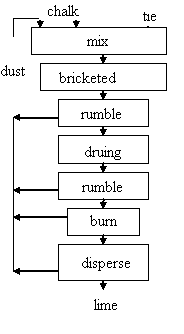| DonNTU Master's portal | ENG UKR RUS |

Shkarban Aleksandra
Faculty: Faculty of ecology and chemical technology
Speciality "Metallurgy ecology"
The analysis of resource savings, power savings, improvement of production technologies of a lime
Scientific adviser: Kochura Vladimir
|
||||
|
Contents 2. Objective and problems of a diploma thesis: 4. The urgency of subject matter 5. The practical importance of results 6. The review of development and researches on subject matter 1. INTRODUCTION
Lime is consumed by various industries and
consequently varied demands are made to its quality.
Reception of a product with the set properties,
adequating the requirements of various branches
of a national economy, requires exploitation of
appropriating technological modes and designs of
furnaces.
The above-listed types of oven units have the
essential lacks connected with raised expense
of fuel and changeable 2. Objective and problems of a diploma thesis:To reflect a urgency of comparison the resource-energysaving parameters
of alternative versions of manufacture 3. Novelty of workNovelty of work consists that are offered for introduction in manufacture of the lime modern resource-energysaving technologies which allow to reach planned objectives and problems of this work. 4. The urgency of subject matterManufacture of fluxes is one of the most scale and acute problems of ferrous metallurgy
in particularly by manufacture especially pure steel.
At the same time there is a problem of rational using of minerals,
major of which are metallurgical or flux limestones.
Despite of prevalence of limestones in the nature, the supplies of flux
limestones are limited. 5. The practical importance of resultsResult of the given work — development of technological methods for introduction in conditions of manufacture of lime. Use of these methods will allow the enterprise to organize more effective manufacture of lime, having provided the minimal negative influence of manufacture on an environment, will allow to lower possible ecological payments for emissions, will lower a net cost of production due to decrease in power inputs and reduction of ecological payments. 6. The review of development and researches on subject matterAre developed various versions and technological diagrams of preparation and recycling secondary material and power resources by manufacture of lime. The diagram of manufacture of lime Natural chalk with natural humidity of 25 % and a total content of carbonates
of calcium and magnesium of 92-97 % is extracted by the open way and motor transport
delivered to the basic manufacture.[2,1-2] 
Technology of reception of lime from the bricketed cretaceous crumbObjective of technology: 
This technology provides the maximal degree of recycling of secondary resources in manufacture of fluxes in comparison with known analogues. Provides stably high quality and low cost of a product. 7. Existing results By results of the analysis of work, have been allocated the basic existing
alternative versions of manufacture to exhaust from the advanced waste: Literature1. Металлург, 8 (2004). 2. Табунщиков Н.П., Исследование шахтных известково-обжигательных печей. — М.—Л., 1977г. — 362 с. 3. Смирнов Л.А. Использование ожелезненного известково-магнезиального флюса в конвертерной плавке // Сталь. — 2000, № 11. — С. 46—48. 4. Борисов В.М., Жук А.Д., Матюк И.Я. Перспективы использования дисперсных отходов прокатного производства в черной металлургии (Обзор) // Черная металлургия.- 2001, № 21 (905).— С. 45—60. 5. Гаврин Э.Г., Абросимов А.С. Производство конвертерного железофлюса из промасленной окалины // Бюллетень.— 2005, № 2. —С. 32—33. 6. Дидковский В.К., Роговцев Н.И. Технология производства и применения конвертерного флюса // Сталь. — 2003, № 5. — С. 410—412. 7. Металл и литьё Украины, 2—11’2002год. 8. Брусиловский Г.Н., Производство извести — М., 1954г. — 256 с. 9. Монастырев М.И., Производство извести — М., 1986г. — 208 с. 10. Табунщиков Н.П., Производство извести — М., 1974г. — 238 с. 11. Металл и литьё Украины, 3—4 ’2004год. 12. Технология производства железофлюса на Докучаевском флюсо-доломитном комбинате [Электронный ресурс].-Режим доступа: URL: http://www.dfdk.com.ua 13. Организация ресурсосбережения при добыче и использовании флюсов в черной металлургии [Электронный ресурс]. — Режим доступа: URL: http://donntu.ru 14. Портал магистров Доннту, Пономарева Н.[Электронный ресурс]. — Режим доступа: URL: http://masters.donntu 15. Производство извести [Электронный ресурс]. — Режим доступа: URL: http://www.izvesta.com/ 16. Технология производства извести [Электронный ресурс]. — Режим доступа: URL: http://www.ptechnology.ru 17. Бойко, Федоров. Производство извести [Электронный ресурс]. — Режим доступа: URL: http://waste.ua |